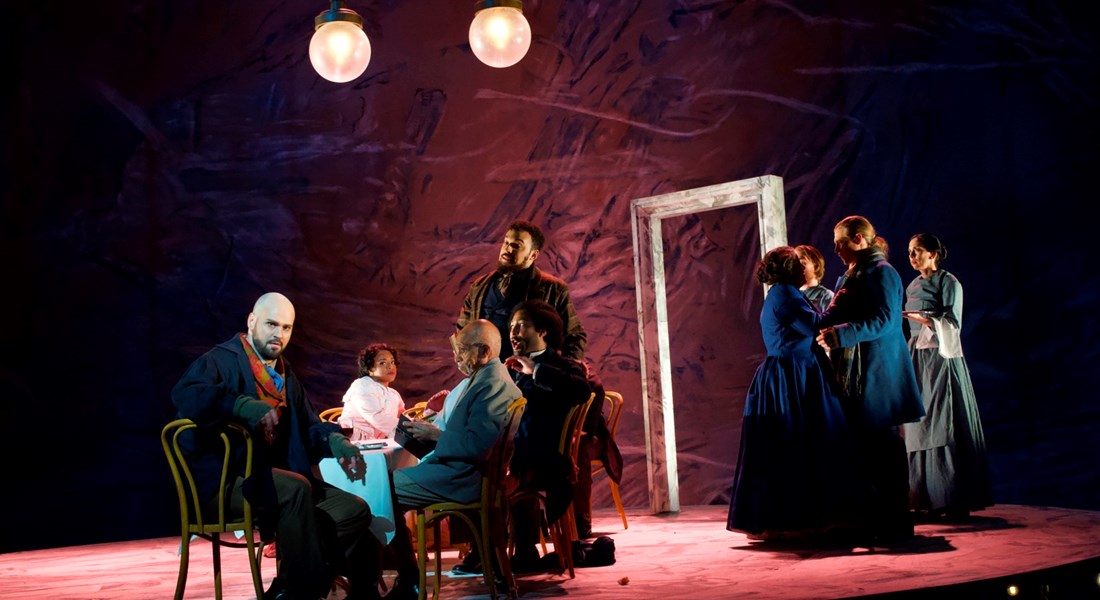Posted19 Apr 2023
- In
Flashbacks and Decisive Moments: Storytelling in La bohème
A pillar of a timeless story is its ability to be retold and still captivate audiences as if it were their first time hearing it. Although the end is already known when re-experiencing a story, audiences still crave the adventure of reliving characters’ journeys to investigate why they make decisions. We return to stories to vicariously experience another’s life while escaping from our own. Of course, we may get invested in a story to see how it turns out, yet many stories garner our attention by making us wonder why and how we reached an incident.
This is precisely why Joshua Barone of the New York Times calls Yuval Sharon’s new production of La bohème, “a production of decisive moments.” This visionary take on the famous opera is presented in reverse order, beginning with the fourth act and ending with the first act in only 100 intermission-less minutes. Barone explains that as we move from the end to the beginning, the Wanderer, a spoken role similar in nature to a narrator, “stops the action to ask questions that make Puccini’s tragedy more about the why than the what of it all."

If we cared more about the what of it all than the why of it all, modern retellings of the opera, such as RENT and Moulin Rouge!, would not continue to draw audiences across multiple mediums. In fact, Moulin Rouge! incorporates the myth of Orpheus and Eurydice into its interpretation of La bohème, so the ending becomes even more predictable. But we do not only care about endings.
At the end of Broadway blockbuster Hadestown, which also retells the myth of Orpheus and Eurydice, a character reminds audiences that “To know how it ends/ And still begin to sing it again/ As if it might turn out this time” draws us back to tragedies. Perhaps if one character made a different decision, another character would have survived. We may get so lost in a story and stand behind a character’s decision that we forget the tragic ending. But why do characters decide to pursue one path rather than another?
A 'backwards bohème' may surprise lovers of the traditional structure, yet it allows us to answer this question. Many television shows, musicals, and films use nonlinear narratives to tell stories that focus more on the how and why of it all rather than the what of it all. For instance, every season of How To Get Away With Murder presents viewers with a shocking crime that happens in the middle of the season to keep audiences questioning how they will arrive at the incident.
Similarly, Broadway’s Wicked begins with the Ozians celebrating the death of the Wicked Witch of the West, then audiences follow the development of the supposed “witch.” When this scene is played again at the end of the musical, audiences notice much more nuance in the emotions of certain characters since they understand why they had to make certain decisions. The Last Five Years tells the story of a broken relationship by moving from end to beginning in the perspective of one character while also moving from beginning to end in the perspective of another character. Other famous theatrical examples of nonlinear narratives include IF/THEN and Merrily We Roll Along.
Experimenting with narrative structure is not a rare storytelling practice, and it allows one to focus on different qualities than they would have if a story were presented chronologically. Audiences can delve into why characters make decisions and how a tragedy occurred, then recognize where the tragedy could have been prevented. The new production of La bohème which plays at The Academy of Music in spring 2023 will take audiences on an analytical journey to discover how the tragedy was inevitable, yet hope still prevails.
Blake Velick is a senior at the University of Pennsylvania and interned in Opera Philadelphia's Marketing & Communications department in summer 2022.
Leave your comment below.

 Facebook
Facebook Twitter
Twitter More
More